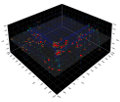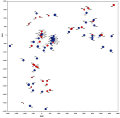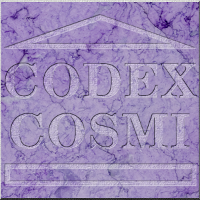
The Local Group of Galaxies
Most galaxies form groups of galaxies – with a few to a few tens of galaxies - and clusters of galaxies, which contain from a few tens to several hundreds of galaxies. Within these groups the distances between galaxies are typically from tens to thousands of kiloparsecs. While galaxy groups are often far from spherical, one can say that their diameters range from one to twenty megaparsecs. The few galaxies that do not belong to groups are between groups and are called field galaxies. Our own galaxy, the Milky Way, belongs to the Local Group of galaxies (often abbreviated as LG).
Galaxy groups stay together as groups, and are defined as groups, due to the gravitational interaction, i.e. dynamics, they impose on each other. Usually a group has two or three massive galaxies that dominate the dynamics of the group and a variety of smaller galaxies, which more or less orbit the massive ones or are exchanged between them, or in some cases are flung out of the system altogether when they fly close to a massive galaxy. It is also possible that the massive one devours a dwarf galaxy that comes too close.
The Local Group of Galaxies
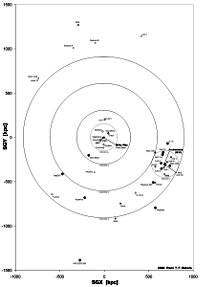
The Local Group consists of two giant spiral galaxies; the Milky Way and the Andromeda Galaxy; a few medium sized galaxies; M33, Large Magellanic Cloud, and Small Magellanic Cloud; and approximately forty dwarf galaxies. The total number is not known because some small dwarf galaxies may be so faint that they have not been detected yet, but mainly because a large part of the sky is covered by our own galaxy and there may be a number of galaxies, even large ones, lurking behind the dust and gas clouds of the Milky Way.
The Milky Way - Andromeda Galaxy pair dominates the Local Group dynamics. Most of the smaller Local Group galaxies orbit either one. Some dwarf galaxies have clearly been flung out of the Local Group by one of these giants. There are some field galaxies nearby, which could eventually be pulled into the Local Group by its combined gravitational pull.
The Extended Local Group of Galaxies
Sometimes other nearby groups are included in the Local Group and then we talk about the extended Local Group of galaxies (this is sometimes abbreviated as ELG). Please see also an article on Local Volume. These other groups may have played an important rôle in the Local Group dynamics, or may still do so.
The most prominant such group is Maffei Group, also known as IC342/Maffei Group or sometimes IC342 Group. The Maffei Group lies behind the central regions of the Milky Way and was therefore found only in the late 1960's when Italian astronomer Paolo Maffei discovered two giant galaxies, Maffei 1 and Maffei 2. It took a decade or two before astronomers realised that there is a whole group out there and it is quite nearby.
Another group that is often included in the Extended Local Group of galaxies is Sculptor Group. The Sculptor Group is not hidden behind dust and gas in the Milky Way around us but it is quite sparce and therefore not easily described. An old description includes galaxies from a wide range, from about one megaparsec to six megaparsecs. There seems to be a clear break in the middle, so later the group has been divided into two subgroups, so called B7a and B7b in some catalogues. The nearer one clearly has some importance to the Local Group and one or two galaxies traditionally included in the Sculptor group may, in fact, be members of our own Local Group.
The Extended Local Group Dynamics
Dynamics of galaxies, i.e. gravitational effects caused and experienced by bodies in galaxies, is studied in order to understand how galaxies are formed and how they develop. The objective is to learn to predict their behaviour in the future. Objective is the same for groups of galaxies. We think groups have formed mainly from fluctuations in the matter distribution created by the Big Bang. A totally homogeneous matter distribution could not evolve into the highly structured and complex universe as ours. On the other hand it is interesting to study the development of galaxy groups: why groups are what they are, why do they form filamentary structures in the universe, why do they stick together, how do they function.
Studying group dynamics, especially of our own Local Group of galaxies, we can fathom the structure, workings, and history of the group and estimate the age of the universe independent from expansion of the universe. The best method to study interactions between galaxies is the use of computer simulations. All known properties are fed into simulations, along with an estimate of the properties less well known. Simulations use a model of galaxy movements following laws of physics programmed into the model. The most important of these laws is Newton's theory of gravity, which the computer uses to move the galaxies around.
In my own simulations I assumed the universe was formed in the Big Bang, the matter later known as the Local Group has stayed in a uniform collection of matter ever since, and galaxies formed with time without disturbing matter flows in the group and orbited each other ending up in their current locations. In the simulation, galaxy movements are followed from present time backward almost to the big bang. In order to get a sensible result, poorly known properties of galaxies must be fine-tuned until all galaxies merge within a suitable time (in this backward running time frame).
On the right you can see two images of the results of the simulations. On the top image, galaxy movements are shown in the chosen supergalactic cartesian coordinate system from the top or from the direction of positive z axis down towards the x–y plane. In the supergalactic cartesian coordinate system axes are called SGX, SGY and SGZ. In the bottom image the same trajectories are shown from the side, or from the direction of negative y axis towards x–z plane.
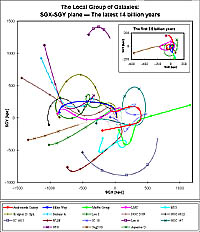
The curves on the images are trajectories of galaxies from the Big Bang till present time. As all matter was very densely packed right after the Big Bang and the trajectories form a confusing mess, the first 3.5 billion years have been made almost invisibly light in the main images and presented in inserts instead. Current locations of the galaxies are shown with filled symbols at the ends of curves. The open symbols or crosses on trajectories present the galaxy locations at an interval of 3.5 billion years so that the galaxies are at the symbol free ends of curves 3.5 billion after the Big Bang (in places where the very light parts of the curves meet the fully coloured parts). At 7 billion years galaxies were at the first cross, at 10.5 billion years at the second cross and at 14 billion years at the third cross. They have reached their current locations at the filled symbols in 17.5 billion years after the Big Bang.
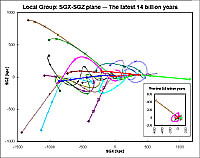
Galaxies are shown with different colours that are explained at the bottom of the top image. The most important galaxies are the dark blue Milky Way, the red Andromeda Galaxy and the light green Maffei Group of galaxies (all bundled together in one spot).
My simulations suggest the age of the universe is 17.5 billion years. I presumed three quarters of the galaxy masses to be of dark matter and I noticed that the more massive the galaxies are, the older the universe becomes. Therefore the 99 per cent dark matter shares of galaxy masses that some cosmologists once suggested would mean the universe would be tens or maybe even hundreds of billions of years old. The reason for this is the orbit the Milky Way and Andromeda Galaxy are making around each other. These two giant spiral galaxies are currently approaching each other and therefore they must have made at least one loop on their dance together. The more massive the galaxies are, the larger this loop must have been so that the galaxies end up at their current locations and reach the observed velocity they are approaching each other with (roughly 120 kilometres per second). The larger the loop, the more time it takes. Since the WMAP results were released, we have known that the age of the universe is roughly 13.7 billion years. When this age is applied to these simulations, you find the fraction of dark matter in the Milky Way and Andromeda Galaxy must be quite small — certainly much less than three quarters of the total mass.
Taustan kuva:
Background image:
ESO




